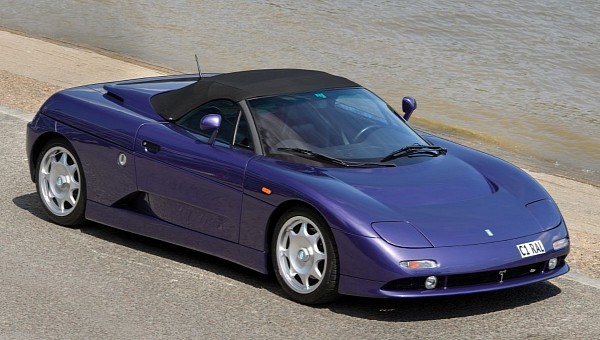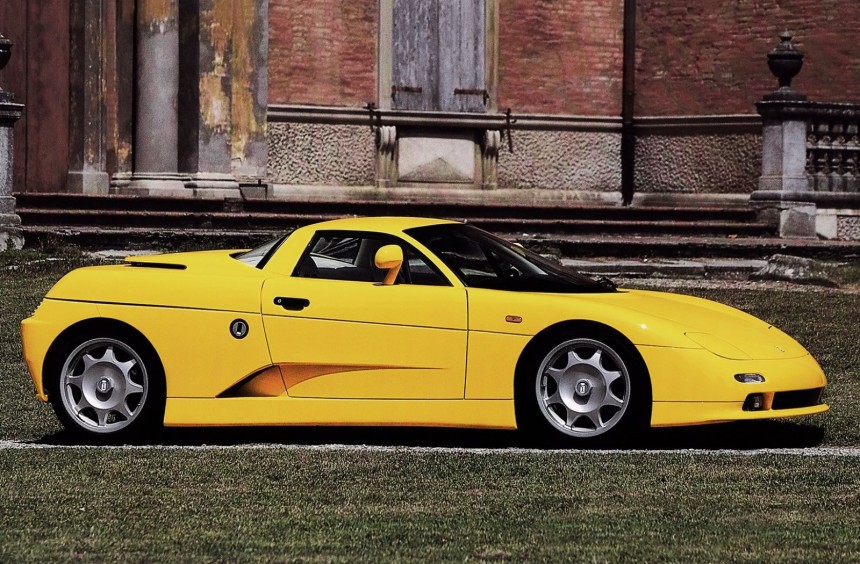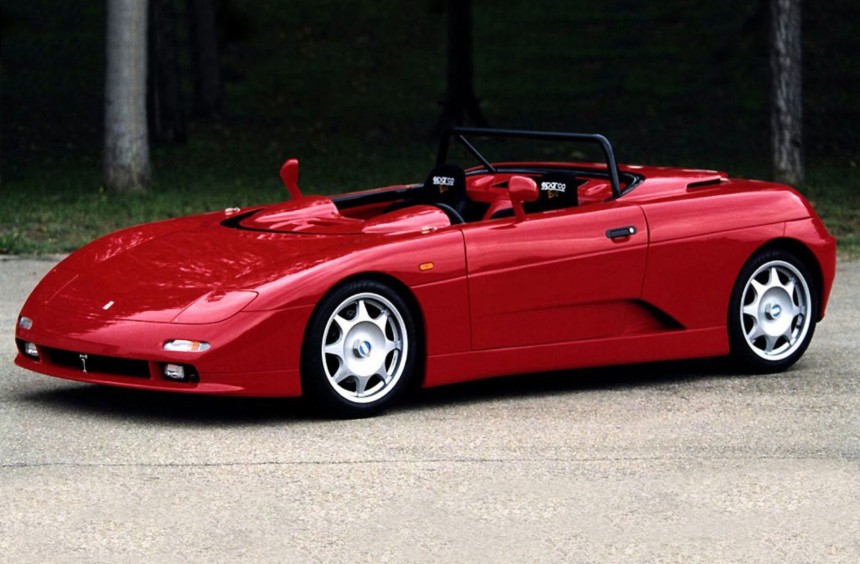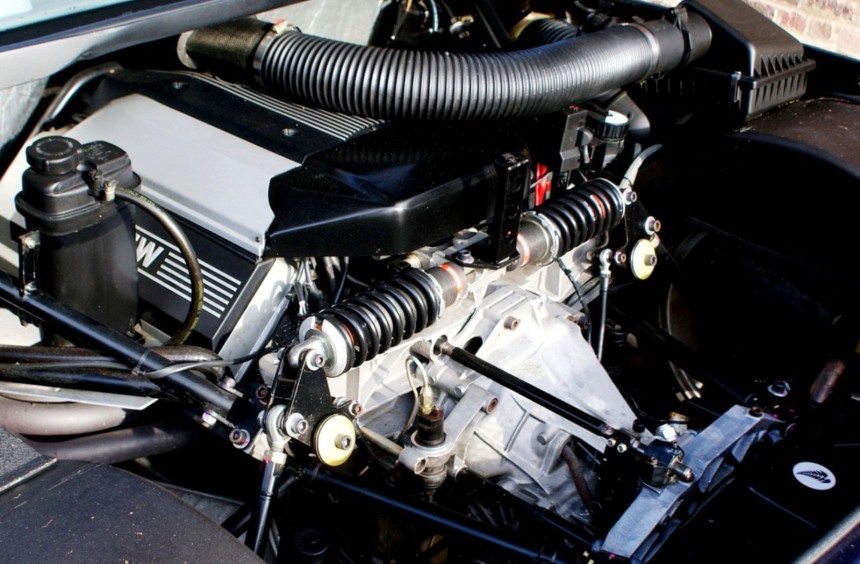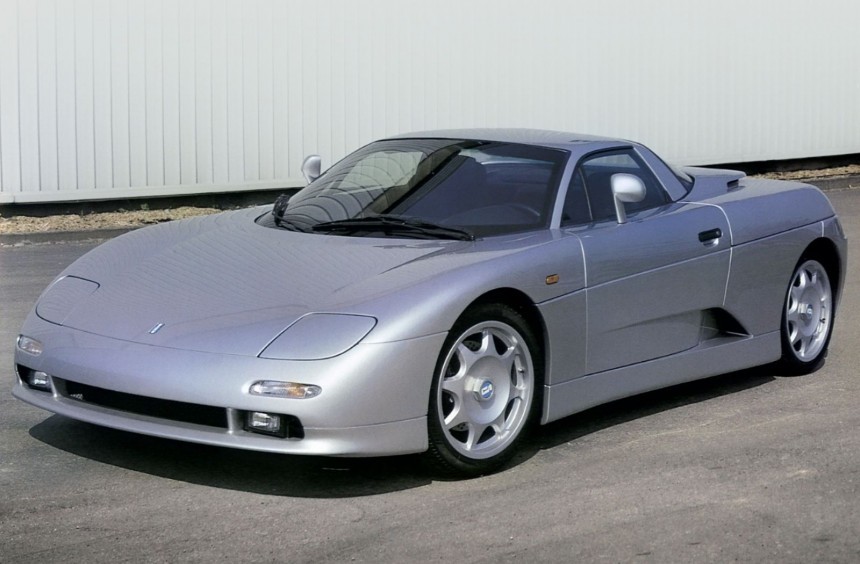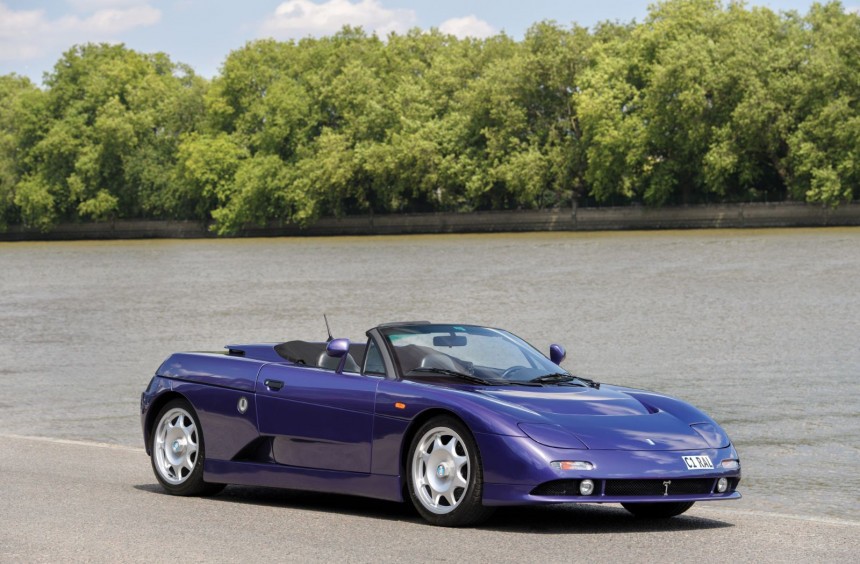Decently powerful, lightweight, and brimming with motorsport-derived tech, the Guarà was a masterfully-built sports car. Despite that, it failed to make a splash in a very crowded market segment, mainly because it didn’t don Ferrari or Lamborghini badges.
After pursuing a career as a Formula 1 driver, but ultimately failing, Argentine-born Alejandro de Tomaso set his sights on building fast cars in Italy and founded De Tomaso Modena SpA (later De Tomaso Automobili) in 1959.
The company’s first road-going model was the small Vallelunga, followed by the bigger Ford V8-powered Mangusta, but unquestionably its greatest hit was the Pantera. While it shared many commonalities with its predecessor, such as a mid-mounted, American-built V8, it was a better car in just about every way.
Italian styling and maneuverability combined with powerful and reliable American muscle made it a popular choice for sports car enthusiasts all over the world.
Ford had acquired the majority stake from Alejandro and his associate in 1971, shortly after the Pantera was revealed, so that meant that American customers could buy one from Ford’s dealerships.
That helped boost its popularity, but when the 1973 oil crisis hit, Ford sold their 84% stake back to Alejandro, so U.S. owners or potential buyers were suddenly left with no dealership network to source parts or buy new Panteras.
After the split-up with Ford, De Tomaso continued marketing the Pantera in Europe for nearly two more decades. It was continually improved, becoming a legit contender for Italian heavyweights like Ferrari or Lamborghini.
The Pantera’s success helped the company grow to the point where it was able to take hold of other Italian brands like Motto Guzzi (1973), Innocenti, and Maserati (both acquired in 1976).
By 1992, it was clear that the successful mid-engine sports car needed a successor. But one-upping the Pantera would require something truly special, so De Tomaso turned to the world of motorsports.
At the time, the company’s Modena factory was manufacturing the Maserati Barchetta, a mid-engine race car designed and developed for the one-make racing series Grantrofeo Barchetta, which took place in 1992 and 1993 in Italy, as well as select circuits on the Old Continent.
Weighing only 1,709 lb (775 kg), sitting on a Formula 1-derived, push-rod suspension system, and employing a 315-hp, mid-mounted, twin-turbo V6, the Barchetta was a lethal track weapon. It had a terrific power-to-weight ratio, which made it a joy to drive on technical courses.
To promote both the one-make series and the struggling Maserati brand, De Tomaso flirted with the idea of building and producing a handful of Stradale (street) versions, going as far as developing a fully-functional prototype. However, in 1993, Maserati was taken over by automotive giant Fiat, and the Stradale, along with the whole Barchetta project, was canceled.
Despite this, the Stradale prototype remained in De Tomaso’s possession, and it served as the base for the Pantera’s successor.
Named Guarà and unveiled to the public at the 1993 Geneva Motor Show, De Tomaso’s new model was meant to blur the line between a sports car and a full-blown supercar.
Instead of the force-fed Maserati V6 that powered the Stradale prototype, the Guarà received BMW’s newly-introduced M60B40. A naturally-aspirated, all-aluminum unit, the 4.0-liter dual overhead cam (DOHC) engine shared with the E31 8 Series (840Ci) was only slightly modified in Italy, so its output didn’t improve, hovering around 280 hp.
Nevertheless, it was mounted mid-ship, and combined with the Guarà’s 2,646 lb (1,200 kg) curb weight, it delivered enough power to make for a thrilling driving experience.
Moreover, the car was built around a slightly modified version of the Barchetta Stradale’s all-aluminum, backbone tube chassis, which retained the Brembo braking system which was similar to that of the Ferrari F40, as well as the pushrod suspension designed by renowned Formula 1 engineer Enrique Scalabroni.
Even if it lacked the power of monsters such as the Lamborghini Diablo, the Ferrari 512 TR, or the Porsche 959, the motorsport-derived tech it employed made it extremely agile and, as those who got to drive it can attest, it delivered an unforgettable driving experience, similar to what one would feel in one of the aforementioned supercars.
Unlike the Maserati Barchetta Stradale it was based on, the Guarà was initially available only as a coupe. Stylized by Carlo Gaino at Synthesis Design, the body was fabricated out of lightweight composites such as fiberglass or Kevlar, yet the overall look was far from a four-wheeled masterpiece.
From the outside, the car looked like a squashed Corvette that was re-bodied by someone in their own backyard. Well, maybe I’m being too critical of Gaino’s work, but I’m sure you can agree that it was nowhere near the Lambos, Ferraris, or Porsches of the era in terms of design.
That, combined with the high price tag and the fact that it didn’t feature Ferrari, Lamborghini, or Porsche badges, made wealthy enthusiasts reluctant to buy one, so the sales figures were nowhere near what De Tomaso accomplished with the Pantera. While the company managed to sell 5,262 units of the Pantera from 1971 through 1974 in the U.S. alone, only around 50 Guaràs left the Modena factory in a decade of production.
In an attempt to make the Guarà more desirable, the company rolled out a Spyder (convertible) version, as well as an open-top, windshield-less Barchetta. These new body styles, particularly the Barchetta, made the car look noticeably better, but still didn’t help boost sales.
Another attempt to make the car more desirable was a new engine. Driven by both BMW’s decision to phase out the M60 eight-cylinder and the need for more power, De Tomaso eventually revived its partnership with Ford and started equipping Guaràs with 4.6-liter supercharged V8s sourced from the American manufacturer.
While this upped the output to a respectable 316 hp, the chunky cast-iron block engine also added 441 lb (200 kg), so the car didn’t become noticeably faster. Moreover, the powerplant was bigger than the BMW V8 and didn’t allow enough room for the convertible canvas top, leading to the discontinuation of the Spyder version.
The coupe and Barchetta were both manufactured until 2004, when production finally ceased. Including the prototypes, 54 units were built, a lot less than the carmaker had initially anticipated.
The last model built by De Tomaso, under Alejandro’s ownership, the Guarà was a financial disaster. Shortly after the founder’s death in 2003, the company went into liquidation and changed several owners until being bought by Hong-Kong based Consolidated Ideal Team Ventures in 2014. Luckily, the brand was revived and in 2019 it unveiled the gorgeous P72, which is scheduled to begin production this year.
Despite its commercial failure, the Guarà was an epic car in terms of driving experience thanks to its Formula 1-derived hardware. It may not have been the prettiest sports car of its era, but out on a windy road or on a technical track, you would quickly forget about its looks and develop an addiction to its near-flawless agility. It remains a thoroughbred driver’s car and one of the most underrated sports cars of the 1990s.
You can watch a slideshow of its development history in the YouTube video below by Pianeta Modena.
The company’s first road-going model was the small Vallelunga, followed by the bigger Ford V8-powered Mangusta, but unquestionably its greatest hit was the Pantera. While it shared many commonalities with its predecessor, such as a mid-mounted, American-built V8, it was a better car in just about every way.
Italian styling and maneuverability combined with powerful and reliable American muscle made it a popular choice for sports car enthusiasts all over the world.
Ford had acquired the majority stake from Alejandro and his associate in 1971, shortly after the Pantera was revealed, so that meant that American customers could buy one from Ford’s dealerships.
That helped boost its popularity, but when the 1973 oil crisis hit, Ford sold their 84% stake back to Alejandro, so U.S. owners or potential buyers were suddenly left with no dealership network to source parts or buy new Panteras.
Attempting to build a better successor
The Pantera’s success helped the company grow to the point where it was able to take hold of other Italian brands like Motto Guzzi (1973), Innocenti, and Maserati (both acquired in 1976).
By 1992, it was clear that the successful mid-engine sports car needed a successor. But one-upping the Pantera would require something truly special, so De Tomaso turned to the world of motorsports.
It started life as a Maserati race car
Weighing only 1,709 lb (775 kg), sitting on a Formula 1-derived, push-rod suspension system, and employing a 315-hp, mid-mounted, twin-turbo V6, the Barchetta was a lethal track weapon. It had a terrific power-to-weight ratio, which made it a joy to drive on technical courses.
To promote both the one-make series and the struggling Maserati brand, De Tomaso flirted with the idea of building and producing a handful of Stradale (street) versions, going as far as developing a fully-functional prototype. However, in 1993, Maserati was taken over by automotive giant Fiat, and the Stradale, along with the whole Barchetta project, was canceled.
Despite this, the Stradale prototype remained in De Tomaso’s possession, and it served as the base for the Pantera’s successor.
Ditching the twin-turbo V6 in favor of a German-built, aspirated V8
Instead of the force-fed Maserati V6 that powered the Stradale prototype, the Guarà received BMW’s newly-introduced M60B40. A naturally-aspirated, all-aluminum unit, the 4.0-liter dual overhead cam (DOHC) engine shared with the E31 8 Series (840Ci) was only slightly modified in Italy, so its output didn’t improve, hovering around 280 hp.
Nevertheless, it was mounted mid-ship, and combined with the Guarà’s 2,646 lb (1,200 kg) curb weight, it delivered enough power to make for a thrilling driving experience.
Moreover, the car was built around a slightly modified version of the Barchetta Stradale’s all-aluminum, backbone tube chassis, which retained the Brembo braking system which was similar to that of the Ferrari F40, as well as the pushrod suspension designed by renowned Formula 1 engineer Enrique Scalabroni.
Even if it lacked the power of monsters such as the Lamborghini Diablo, the Ferrari 512 TR, or the Porsche 959, the motorsport-derived tech it employed made it extremely agile and, as those who got to drive it can attest, it delivered an unforgettable driving experience, similar to what one would feel in one of the aforementioned supercars.
The exterior design and lack of brand prestige translated to poor sales
From the outside, the car looked like a squashed Corvette that was re-bodied by someone in their own backyard. Well, maybe I’m being too critical of Gaino’s work, but I’m sure you can agree that it was nowhere near the Lambos, Ferraris, or Porsches of the era in terms of design.
That, combined with the high price tag and the fact that it didn’t feature Ferrari, Lamborghini, or Porsche badges, made wealthy enthusiasts reluctant to buy one, so the sales figures were nowhere near what De Tomaso accomplished with the Pantera. While the company managed to sell 5,262 units of the Pantera from 1971 through 1974 in the U.S. alone, only around 50 Guaràs left the Modena factory in a decade of production.
The return to Ford power and new body styles didn’t help
Another attempt to make the car more desirable was a new engine. Driven by both BMW’s decision to phase out the M60 eight-cylinder and the need for more power, De Tomaso eventually revived its partnership with Ford and started equipping Guaràs with 4.6-liter supercharged V8s sourced from the American manufacturer.
While this upped the output to a respectable 316 hp, the chunky cast-iron block engine also added 441 lb (200 kg), so the car didn’t become noticeably faster. Moreover, the powerplant was bigger than the BMW V8 and didn’t allow enough room for the convertible canvas top, leading to the discontinuation of the Spyder version.
The coupe and Barchetta were both manufactured until 2004, when production finally ceased. Including the prototypes, 54 units were built, a lot less than the carmaker had initially anticipated.
The last model built by De Tomaso, under Alejandro’s ownership, the Guarà was a financial disaster. Shortly after the founder’s death in 2003, the company went into liquidation and changed several owners until being bought by Hong-Kong based Consolidated Ideal Team Ventures in 2014. Luckily, the brand was revived and in 2019 it unveiled the gorgeous P72, which is scheduled to begin production this year.
Despite its commercial failure, the Guarà was an epic car in terms of driving experience thanks to its Formula 1-derived hardware. It may not have been the prettiest sports car of its era, but out on a windy road or on a technical track, you would quickly forget about its looks and develop an addiction to its near-flawless agility. It remains a thoroughbred driver’s car and one of the most underrated sports cars of the 1990s.
You can watch a slideshow of its development history in the YouTube video below by Pianeta Modena.
